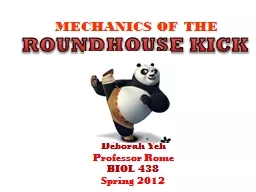

MECHANICS OF THE Deborah Yeh Professor Rome BIOL 438 Spring 2012 ROUNDHOUSE KICK What is Tae Kwon Do Tae Kwon Do A Korean unarmed martial art distinguished by its emphasis on kicking techniques Mainly used for selfdefense but can also be a sport ID: 771699
Download Presentation The PPT/PDF document "MECHANICS OF THE Deborah Yeh" is the property of its rightful owner. Permission is granted to download and print the materials on this web site for personal, non-commercial use only, and to display it on your personal computer provided you do not modify the materials and that you retain all copyright notices contained in the materials. By downloading content from our website, you accept the terms of this agreement.
MECHANICS OF THE Deborah YehProfessor RomeBIOL 438Spring 2012 ROUNDHOUSE KICK
What is Tae Kwon Do?Tae Kwon Do : A Korean unarmed martial art distinguished by its emphasis on kicking techniques.Mainly used for self-defense, but can also be a sport.Variety of types of kicksPositionDifficulty levelCombos
Basic Kicks in Tae Kwon Do
What is a Roundhouse Kick?Most frequently used kick in TKD 60% of kicks in TKD championship (Pearson, 1997)Easy to attack from fighting stanceKicking leg travels in an arc towards the front
What is a Roundhouse Kick?
Front View of Roundhouse Kick
Top View of Roundhouse KickKicking leg sweeps across 180° from its initial position Semicircular motion (2 parts)Lift kneeExtend knee Initial position Lift knee Final position Extend leg
Muscles Involved in RHKSpinal flexors, spinal rotators, Gluteus maximus, Rectus femoris, muscles in the foot
Break-down of the RHKPrepare for kick Deliver kickRecovery
Back leg kick
LimitationsNo force plate, cannot accurately measure impulse No punching bagMarkers were sometimes difficult to seeCannot account for 3D motionDescribe Z axis qualitativelyForm is not perfect
Displacement vs. Time
Velocity vs. Time
Calculation: Force of KickForce of kick F=mfootamfoot = 1.4% of 50 kg= 0.7 kgAssume that mass of foot is 1.4% body massa= 74.10 m/s2At peak velocity (t=12.96 s)Slope for plot of X-velocity vs. time: 61.67Slope for plot of Y-velocity vs. time: 41.08a2= 61.672 + 41.082 F= (0.7 kg)(74.10 m/s 2 )= 51.87 N
Calculations: MomentumMomentum: p= mv= 6.314 kg m/smfoot = 0.7 kgv= 9.02 m/s vy= 7.505 m/svx= 5.003 m/sv2 = vx2 + vy2
ImpulseImpulse: J= F∆t; ∆t= 0.024 secJ= 51.87 N x 0.024 sec= 1.25 Ns t= 1.136 v= 2.187 m/s t= 1.160 v= 0.878 m/s J= ∆mv= 1.5309-0.6146= 0.9163 kg m/s
Energy during KickKinetic Energy: ½ mv 2½ (0.7 kg) (9.02 m/s) 2= 28.48 JPotential Energy: mghh= 1.404 m(0.7 kg)(9.8 m/s2)(1.404 m)= 9.63 JTotal E: 28.48 J + 9.63 J=38.11 J
Horizontal Worka= 11.63 m/s 2Wx= Fdx = mad x= (0.7)(11.63)(1.064m)= 8.66 J
Vertical Worka= 13.00 m/s2Wx= Fdx = madx= (0.7)(13.0)(1.404m)= 12.78 J
Review: Top View of Roundhouse Kick Kicking leg sweeps across 180° from its initial positionSemicircular motion (2 parts)Lift kneeExtend kneeDisplacement of the leg in X, Y, and Z axes Initial position Lift knee Final position Extend leg
135° t= 1.272 s t= 0.248 sAngular Velocity ∆θ = 5∏/ 4 rad ∆ t= 1.024 sec ω =3.834 rad/sec 0°, 0 rad 225°, 5∏/4 rad
Elbow RotationRotation of the elbow/arms generates angular momentum. Conservation of Momentum: Momentum of a closed system remains constantAs arms swing back to original position, the heel of the standing leg rotates, allowing the hips and kicking leg to rotate as well.
clockwise counter-clockwise
How to increase impact velocityImpact velocity = linear distance/time Increase linear distance traveled by foot while keeping elapsed time the same.Reducing time while keeping linear distance the same.
Future Research QuestionsUse program to account for 3D motion Front leg vs. Back leg kickOther turning kicks:Spinning wheel kickTornado kick
Sources Boey, L.W. & Xie, Wei. (2008) Experimental Investigation of Turning Kick Performance of Singapore National Taekwondo Players. Journal of Biomechanics, 42(3), 242-248.Kim, Y.K., Kim, Y.H., & Im, S.J. (2011) Inter-joint coordination in producing kicking velocity of Taekwondo kicks. Journal of Sports Science and Medicine, 10 , 31-38. Pearson, Jake. (1997) Kinematics and Kinetics of the Taekwon -Do Turning Kick . Unpublished Bachelor Degree Dissertation, University of Otago .